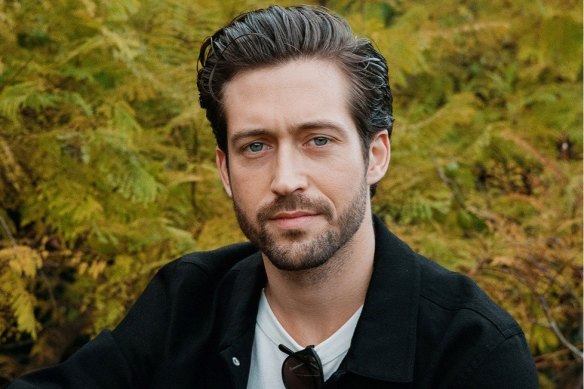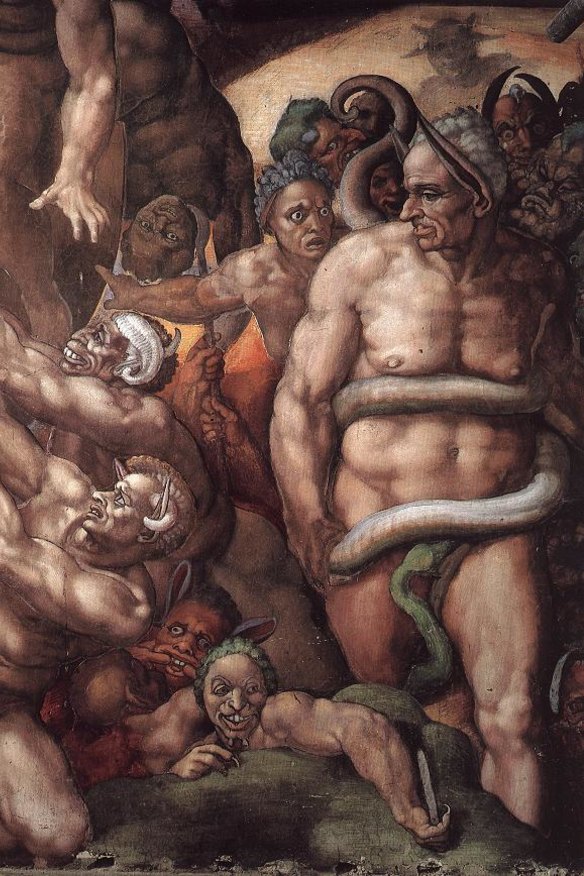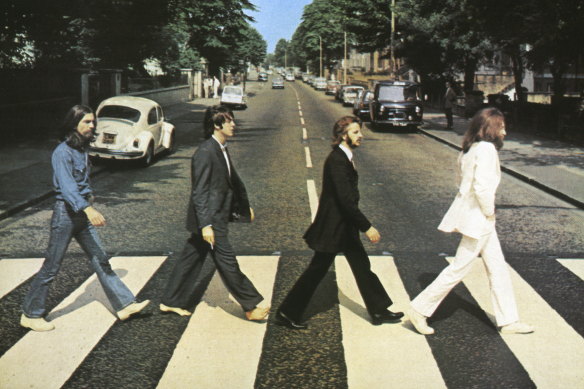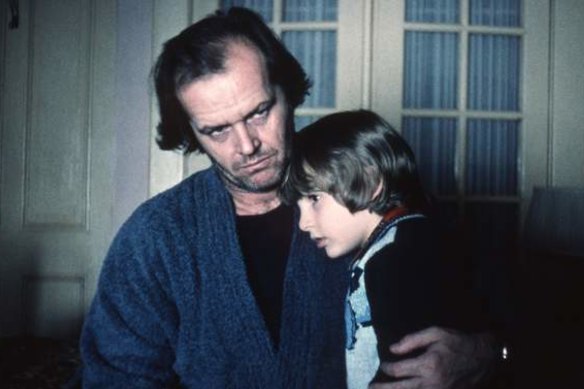This was published 11 months ago
What does Michelangelo have to do with Baby Reindeer? You’ll never guess
Long before Taylor Swift, conspiracy theorists were joining the cultural dots.
By Jordan Prosser

Credit: Marija Ercegovac
Facebook’s algorithms haven’t quite known what to do with me since I relocated from inner Melbourne to regional Victoria. A mid-30s white male who adores cinema and now lives in a conservative-leaning coastal town – why not peruse these second-hand four-wheel drives? How about one of a billion “Marvel shitposting” fan pages? A wellness scam? Your local branch of the Flat Earth Society? A scathing analysis of Disney’s financially ruinous “wokeness”?
This barrage of content – some niche, some frighteningly mainstream, some human-made, some artificially generated – has made me acutely aware of the bleeding together of pop-culture fandom and online conspiracy communities. There’s an enormous crossover in language, behaviour and the types of people and posts that appear on both.

Author Jordan Prosser’s move to regional Victoria has confused Facebook’s algorithms.Credit: Sarah Walker
Of course, this isn’t wholly new; the conspiratorial mindset has always found an outlet through pop culture, in no small part due to the fact that artists have always delighted in embedding hidden meanings, winking in-jokes and artefacts in their work.
Furthermore, there’s long been a tacit agreement between artists and audiences that a certain level of trickery is acceptable – even necessary – for one to entertain and engage the other. This is how art is made, films are shot, albums are recorded and books are written, all thriving off that healthy push-and-pull between a creator’s wilful sleight of hand and the public’s rich imagination.

Minos from Michelangelo’s The Last Judgment.
Michelangelo may have been responsible for one of the first documented “Easter eggs” in popular culture: he put the face of a specific priest he loathed onto the body of the demon Minos in The Last Judgment, his fresco on the altar wall of the Sistine Chapel (with a snake chomping at the man’s genitals, no less). Fast-forward 400 or so years and you’ll find musicians from Pink Floyd to Nirvana sneaking unlisted tracks onto the ends of their albums.
Disgruntled Atari employee Warren Robinett built a secret room in the 1980 video game Adventure that players could find only if they interacted with one specific pixel (annoyed by his lack of a personal credit on the game, the room bears the message “Created by Warren Robinett”; Atari leadership’s response included the first known reference to “Easter eggs” in the modern sense).
This is all good clean fun until people’s imaginations start to get the better of them. In 1966, an urban legend permeated the Beatles’ fandom claiming that Paul McCartney was, in fact, dead – killed in a car accident and replaced by a lookalike. This was (supposedly) explicitly described in the lyrics of A Day in the Life (“he blew his mind out in a car”), as well as being cryptically alluded to on the album artwork for both Sgt. Pepper (in which Paul wears an embroidered patch on his jacket misread as “O.P.D.”, or, “Officially Pronounced Dead”) and the iconic Abbey Road zebra crossing photo (in which the “fake” Paul is walking suspiciously out-of-step with his bandmates and holding a cigarette in his right hand, when everyone knew Paul was a leftie).

The Beatles’ Abbey Road cover sparked frenzied speculation about Paul McCartney’s fate.
The Beatles were also pioneers of “backmasking” – audio snippets recorded backwards, thus obscured unless the whole track is played backwards – and one such secret message on the band’s Revolution 9 (what sounds like “turn me on, dead man”) only fuelled the “Paul is Dead” hypothesis further.
The pearl-clutching around backmasking would reach its peak during the Satanic panic of the 1980s, when religious pundits took the phenomenon to its furthest illogical extreme and contended that many bands were smuggling occult missives into their music. Led Zeppelin’s Stairway to Heaven purportedly intoned “here’s to my sweet Satan” when played in reverse, while Judas Priest were taken to court in 1990 over “subliminal messages” in their cover of Spooky Tooth’s Better by You, Better Than Me, which allegedly drove two teenagers to suicide. (You can hear all these samples for yourself online – the words are there if you know what to listen for.)
Clearly, advances in technology were leading to an uptick in fan-generated intrigue, as well as giving audiences the tools to scrutinise cultural objects more deeply than ever before. Now, in the 21st century, with a sharp increase in consumer media literacy, an equally sharp decrease in institutional trust and a healthy buy-in from certain corners of the pop culture-generating market, we’ve created a runaway effect where all artistic products are presumed to be laden with hidden meaning by default, and every act of creation is seen as involving some degree of deception.
My generation grew up having their eyes opened to the magic of movie-making via extensive DVD behind-the-scenes bonus features, which laid bare the once-mystifying practicalities and tools of filmmaking. Thirty years later, those same tools exist in our pockets. We write, shoot, edit, compose and distribute our own narratives across social media every day. If filmmaking was once akin to a magic trick, then we’re all magicians now; it stands to reason that we should be let in on the secrets of the trade, permitted to peek fully behind the curtain.

Jack Nicholson and Danny Lloyd in The Shining.Credit: AFP
One of the pages I am regularly fed on Facebook is for fans of Stanley Kubrick’s The Shining. A recent post led to a 50-comment-deep discussion over the “meaning” of a television set in the film that features no visible power cord. Any Kubrick pundit could tell you this is likely due to the famously meticulous director not wishing to dirty his frame with unnecessary cabling, but for a particular online audience, this simple aesthetic choice apparently conceals something far more insidious and profound. (The documentary Room 237 does an excellent job of outlining this and many other over-the-top Kubrick conspiracies.)
In other movie forums, pointing out simple goofs and continuity errors – the oldest hobby of nitpicky cinema audiences – has also mutated into the task of identifying mysterious auguries; so-and-so character is holding a prop in their left hand in this shot, then their right hand in the next … what does it all mean? (I wish I could assure this particular poster that all it means is: the film crew was losing light, the script supervisor was having an off day and the editor had no alternative coverage.)
Once you ask your audience to dig a little deeper, you don’t get to decide when they stop digging.
Of course, these attitudes haven’t formed in a vacuum. In the age of viral marketing, many artists and cultural manufacturers have realised it behoves them to play a little coy for the sake of eyeballs, clicks and revenue.
Taylor Swift’s lyrics have always been forensically analysed for coded references to ex-boyfriends and rival pop stars, but with her latest album, The Tortured Poets Department, the billionaire singer leant fully into her fans’ fanatical tendencies, feeding them a trail of digital clues in the lead-up to the album’s release and constructing a pop-up library at The Grove shopping mall in Los Angeles crammed with Easter eggs and references to her own “lore”.

Taylor Swift’s tantalising pop-up library at The Grove in LA.Credit: Getty Images
Meanwhile, at the multiplex, the Marvel Cinematic Universe has built its entire brand on secret interconnectivity and the idea that there’s a bigger picture than the one you’re currently seeing – a rarefied tier of experience accessible only to the most eagle-eyed and devoted of fans (so why not a rarefied tier of reality, too?).
Filmgoers have been trained to scrounge every frame of every film for clues as to where the franchise might be headed next, and to stay in their seats until the end of the credits for “stinger” scenes (the filmic equivalent of an album’s hidden track), which may or may not feature some uncredited cameo from some Hollywood A-lister playing some deep-cut 1980s comic book villain.
Marvel’s producers have carefully and deliberately cultivated these proclivities in their audience, essentially weaponising and rewarding their fans’ penchant for online sleuthing to ensure consistent growth in Disney+ subscriptions.
Here’s the issue: this sleuthing impulse, once activated and fostered, is a genie not easily put back in the bottle. Once you ask your audience to dig a little deeper, you don’t get to decide when they stop digging. And the harder and longer they look, the more likely they are to see things that were never there in the first place.
This is why there’s an increasingly fine line between unearthing gossip about Taylor Swift’s exes and suspecting she’s a secret Pentagon asset on the Democratic party payroll; why certain corners of the internet, in the wake of the documentary Quiet on Set: The Dark Side Of Kids TV, are convinced that the Nickelodeon logo design is based on the shape of Epstein island; why millions of people spent days conjuring up outrageous explanations for a poorly photoshopped image of Princess Kate (the royal family being one of our most robust modern-day brands), when the sad reality was that she was figuring out how to break the news of her cancer diagnosis to her kids.
More and more, creators are struggling to control the spread of their audience’s attention, as the debacle around Richard Gadd’s based-on-a-true-story Netflix series Baby Reindeer and the disastrous and highly public “unmasking” of its real-world subjects recently demonstrated.

Richard Gadd and Jessica Gunning in a scene from Baby Reindeer.Credit: Ed Miller/Netflix
What if the people who construct stories for a living have done too good a job of showing general audiences how to do it for themselves – bestowing all the creative freedom but none of the creative responsibility? The explosion of online conspiracies during COVID demonstrated that when audiences stop believing mainstream media narratives, they will happily construct their own (and that there are infinite online communities and brands more than willing to indulge and reinforce those narratives).
Stories are safe spaces because stories offer control – and what’s more comforting, in times of uncertainty, than the prospect of a world with no accidents, no mistakes and no coincidences? Wouldn’t it be wonderful if literally everything meant something? Sadly though, as history has repeatedly shown us, sometimes a virus is just a virus. Sometimes a princess is just privately battling cancer.
Sometimes a lyric’s just a lyric, a logo’s just a logo, and a goof is just a goof. But as the internet likes to say: there are cathedrals everywhere for those with eyes to see. The same goes for conspiracies.
Jordan Prosser’s debut novel, Big Time, is published by UQP on July 2, $34.99.